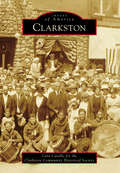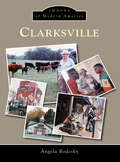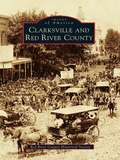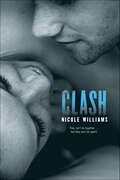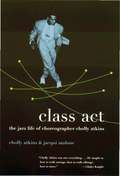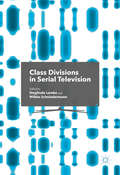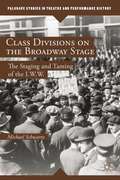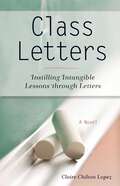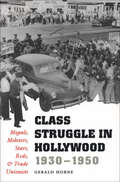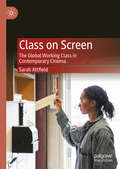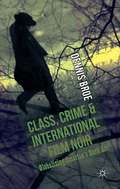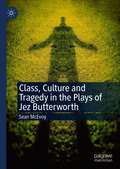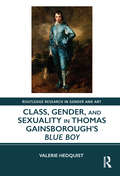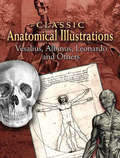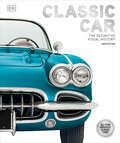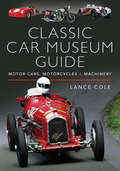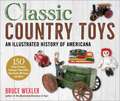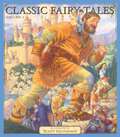- Table View
- List View
Clarkston (Images of America)
by Cara Catallo Clarkston Community Historical SocietyThe noteworthy architecture throughout Clarkston remains a tribute to a time when brothers Jeremiah and Nelson Clark were among the early settlers. In 1838, the enterprising Clarks bought Butler Holcomb's sawmill, quickly building a larger dam and adding a gristmill. In 1842, the Clarks platted the village that would bear their name. The next decade brought trains to the new Clarkston depot, enabling easier commerce and a stronger stream of vacationers visiting the inns and cottages that dotted the banks of Deer Lake, Parke Lake, and the Mill Pond. In the 20th century, the same waterpower enticed Henry Ford to construct a hydroelectric factory on the Clarkston Mills property and renovate the former Clarkston School building on Main Street into a small manufacturing plant. The Ford Motor Company also transformed a farm on the outskirts of town into a renowned tractor-training facility. Today, Clarkston's national historic district remains a testament to its mill-town heritage.
Clarksville (Images of Modern America)
by Angela RodeskyClarksville may have been put on the map as a major tobacco port at the confluence of the Cumberland and Red Rivers, but ever since the founding of Fort Campbell--home of the 101st Airborne Division--in 1942, Clarksville has expanded rapidly and is currently the fifth-largest city in the state of Tennessee. Reinvention of its historic mainstays, such as Austin Peay State University and the Roxy Theatre, has brought new cultural activity to the area. The Monkees' 1966 hit single "Last Train to Clarksville" was inspired by the local Louisville & Nashville Railroad depot. The Leaf-Chronicle, Tennessee's oldest newspaper, has continued to publish in Clarksville, capturing its endless growth and redevelopment. Today, the tight-knit community continues to uphold its brand as "Tennessee's Top Spot."
Clarksville and Red River County
by Red River County Historical SocietyRed River County and Clarksville are actually older than the state of Texas itself. Once known as the Red River District, the area represented all or part of 39 present-day Texas counties. Some of the area's earliest Anglo settlements could be found along the Red River as early as 1816 and included Pecan Point, the Burkham Settlement, and Jonesboro, followed by the settling of Clarksville in 1833. Many of Texas's earliest pioneers passed through the county, including Sam Houston, who spent his first night in Texas in Jonesboro at James and Isabella Clark's home; and Davy Crockett, who spent time at Whiterock at John Stiles's home before he perished at the Battle of the Alamo. Today Red River County is known as the "Gateway to Texas."
Clarksville in Vintage Postcards
by Billyfrank MorrisonClarksville, Tennessee, has undergone a colossal metamorphosis since the 1700s, when men like Sevier, Montgomery, and Renfroe fought Native Americans along the Cumberland and Red Rivers. Though these founding fathers would not recognize the present rivers, nor the hills upon which Clarksville has grown, Clarksvillians have kept an awareness of their rich past, bridging their lives with those of the early frontiersmen. Today, Clarksville eclectically blends both metropolitan and rural settings to offer residents the best of both worlds.
Clash: Includes Crash, Clash And Crush (Crash #2)
by Nicole WilliamsThe second book in the New York Times bestselling Crash trilogy!Their Romeo-and-Juliet-level passion is the only thing Jude and Lucy agree on. That, and fighting all the time . . .Also not helping? Lucy's raging jealousy of the cheerleader who's wormed her way into Jude's life.While trying to hang on to her quintessential bad boy and also training to be the top ballet dancer in her class, Lucy knows something's going to give . . . soon.How can she live without the boy she loves? How can she live with herself if she gives up on her dreams? If Lucy doesn't make the right choice, she could lose everything.
Class Act: The Jazz Life of Choreographer Cholly Atkins
by Jacqui Malone Cholly AtkinsCholly Atkins's career has spanned an extraordinary era of American dance. He began performing during Prohibition and continued his apprenticeship in vaudeville, in nightclubs, and in the army during World War II. With his partner, Honi Coles, Cholly toured the country, performing with such jazz masters as Louis Armstrong, Cab Calloway, and Count Basie. As tap reached a nadir in the fifties, Cholly created the new specialization of "vocal choreography," teaching rhythm-and-blues singers how to perform their music by adding rhythmical dance steps drawn from twentieth-century American dance, from the Charleston to rhythm tap. For the burgeoning Motown record label, Cholly taught such artists as the Supremes, Smokey Robinson and the Miracles, the Temptations, Gladys Knight and the Pips, and Marvin Gaye to command the stage in ways that would enhance their performances and "sell" their songs.Class Act tells of Cholly's boyhood and coming of age, his entry into the dance world of New York City, his performing triumphs and personal tragedies, and the career transformations that won him gold records and a Tony for choreographing Black and Blue on Broadway. Chronicling the rise, near demise, and rediscovery of tap dancing, the book is both an engaging biography and a rich cultural history.
Class Divisions in Serial Television
by Sieglinde Lemke Wibke SchniedermannThis book brings the emergent interest in social class and inequality to the field of television studies. It reveals how the new visibility of class matters in serial television functions aesthetically and examines the cultural class politics articulated in these programmes. This ground-breaking volume argues that reality and quality TV's intricate politics of class entices viewers not only to grapple with previously invisible socio-economic realities but also to reconsider their class alignment. The stereotypical ways of framing class are now supplemented by those dedicated to exposing the economic and socio-psychological burdens of the (lower) middle class. The case studies in this book demonstrate how sophisticated narrative techniques coincide with equally complex ways of exposing class divisions in contemporary American life and how the examined shows disrupt the hegemonic order of class. The volume therefore also invites a rethinking of conventional models of social stratification.
Class Divisions on the Broadway Stage
by Michael SchwartzExamining twenty-five years of theatre history, this book covers the major plays that feature representations of the Industrial Workers of the World. American class movement and class divisions have long been reflected on the Broadway stage and here Michael Schwartz presents a fresh look at the conflict between labor and capital.
Class Letters: Instilling Intangible Lessons through Letters
by Claire Chilton LopezIn Class Letters, we meet Anne English, single mom and high school English teacher (yes, she enjoys the irony). She loves the students she teaches, and hopes to not only educate them, but to prepare them for life after high school. In an attempt to connect with her senior English class on a deeper, more personal level, Anne begins to write them monthly letters, addressing intangibles such as honesty, gratitude, and love. To her surprise and delight, her students reply with heartfelt responses, sharing many of their personal challenges and successes. Class Letters follows Anne and her students through one full school year—revealing their many ups and downs, and showing how authentic, lasting connections can be made through the exchange of letters.
Class Struggle in Hollywood, 1930–1950: Moguls, Mobsters, Stars, Reds, & Trade Unionists
by Gerald Horne&“A taut narrative in elegant prose . . . Horne has unearthed a vitally important and mostly forgotten aspect of Hollywood and labor history.&” —Publishers Weekly As World War II wound down in 1945 and the cold war heated up, the skilled trades that made up the Conference of Studio Unions (CSU) began a tumultuous strike at the major Hollywood studios. This turmoil escalated further when the studios retaliated by locking out CSU in 1946. This labor unrest unleashed a fury of Red-baiting that allowed studio moguls to crush the union and seize control of the production process, with far-reaching consequences. This engrossing book probes the motives and actions of all the players to reveal the full story of the CSU strike and the resulting lockout of 1946. Gerald Horne draws extensively on primary materials and oral histories to document how limited a &“threat&” the Communist party actually posed in Hollywood, even as studio moguls successfully used the Red scare to undermine union clout, prevent film stars from supporting labor, and prove the moguls&’ own patriotism. Horne also discloses that, unnoticed amid the turmoil, organized crime entrenched itself in management and labor, gaining considerable control over both the &“product&” and the profits of Hollywood. This research demonstrates that the CSU strike and lockout were a pivotal moment in Hollywood history, with consequences for everything from production values, to the kinds of stories told in films, to permanent shifts in the centers of power.
Class on Screen: The Global Working Class in Contemporary Cinema
by Sarah AttfieldThis book provides an analysis of the global working class on film and considers the ways in which working-class experience is represented in film around the world. The book argues that representation is important because it shapes the way people understand working-class experience and can either reinforce or challenge stereotypical depictions. Film can shape and shift discussions of class, and this book provides an interdisciplinary study of the ways in which working-class experience is portrayed through this medium. It analyses the impact of contemporary films such as Sorry To Bother You, This is England and Le Harve that focus on working class life. Attfield demonstrates that the global working class are characterised by diversity of race, ethnicity, gender, religion and sexuality but that there are commonalities of experience despite geographical distance and cultural difference. The book is structured around themes such as work, culture, diasporas, gender and sexuality, and race.
Class, Crime and International Film Noir
by Dennis BroeClass, Crime and International Film Noir argues that, in its postwar, classical phase, this dark variant of the crime film was not just an American phenomenon. Rather, these seedy tales with their doomed heroes and heroines were popular all over the world including France, Britain, Italy and Japan.
Class, Culture and Tragedy in the Plays of Jez Butterworth
by Sean McEvoyJez Butterworth is undoubtedly one of the most popular and commercially successful playwrights to have emerged in Britain in the early twenty-first century. This book, only the second so far to have been written on him, argues that the power of his most acclaimed work comes from a reinvigoration of traditional forms of tragedy expressed in a theatricalized working-class language. Butterworth’s most developed tragedies invoke myth and legend as a figurative resistance to the flat and crushing instrumentalism of contemporary British political and economic culture. In doing so they summon older, resonant narratives which are both popular and high-cultural in order to address present cultural crises in a language and in a form which possess wide appeal. Tracing the development of Butterworth’s work chronologically from Mojo (1995) to The Ferryman (2017), each chapter offers detailed critical readings of a single play, exploring how myth and legend become significant in a variety of ways to Butterworth’s presentation of cultural and personal crisis.
Class, Gender, and Sexuality in Thomas Gainsborough’s Blue Boy (Routledge Research in Gender and Art)
by Valerie HedquistThe reception of Thomas Gainsborough’s Blue Boy from its origins to its appearances in contemporary visual culture reveals how its popularity was achieved and maintained by diverse audiences and in varied venues. Performative manifestations resulted in contradictory characterizations of the painted youth as an aristocrat or a "regular fellow," as masculine or feminine, or as heterosexual or gay. In private and public spaces where viewers saw the actual painting and where living and rendered replicas circulated, Gainsborough’s painting was often the centerpiece where dominant and subordinate classes met, gender identities were enacted, and sexuality was implicitly or overtly expressed.
Classic Anatomical Illustrations
by Leonardo Vesalius AlbinusAn awe-inspiring fusion of science and art, this magnificent single-volume reference features more than 130 ground-breaking anatomical illustrations by history's most brilliant artists. Dramatic and highly studied sketches dating back to the sixteenth through eighteenth centuries, these images by Leonardo da Vinci, Bartolommeo Eustachius, Andreas Vesalius, Bernard Albinus, and Pietro da Cortona have given our modern world an unsurpassed appreciation and understanding of the human body.Meticulous portraits of our amazing flesh-and-blood machinery -- many accompanied by the artists' original, handwritten notes -- these time-honored renderings offer important glimpses into the human organism, both inside and out. Art lovers, as well as students of science and medicine, will thrill to these classic adaptations of muscles, limbs, skeletons, nervous and respiratory systems, and other perspectives that, centuries later, remain masterworks of anatomical artistry.
Classic Candy
by Darlene LaceyCandy may well have its origins in medicine (think peppermint sticks), and many Americans still think of candy as an edible salve with which to cure and to celebrate. Today, Americans consume more than 600 billion pounds of the sugary stuff each year. Most Americans have their favorites, their go-to candy bars that bring them comfort. And most of us yearn for the candy of our youth, those treats that made us feel better no matter the occasion. From classics such as the Hershey bar and M&Ms to trend-setters like PEZ and Atomic Fireballs, candy has a special place in our hearts and memories. Lacey details the evolution of candy in America, looking at the classics from a variety of angles. With a look at everything from chocolate to fruity sweets, from simply packaging to product tie-ins, Lacey examines the classic candy of the late-twentieth century, including what it meant--and what it still means--to most of us. Readers will savor this colorful walk down memory lane to Candyland, filled with familiar signposts such as Bazooka, Clark, Necco, and Tootsie Roll.
Classic Car
by DK"When I see an Alfa Romeo, I lift my hat." Henry FordFew things ignite such reverence as a classic car. With more than 250 iconic models from the 1940s to the 1980s, photographed from every angle, this title is a glorious celebration of the stars in the classic car firmament. Edited by award-winning automotive journalist Giles Chapman, Classic Car brings you the story of more than 20 great marques, including household names Bentley, Mercedes, Ferrari, Cadillac, and Aston Martin. Its lavish photography reveals every detail in close-ups of models that range from the 1940s giant two-ton Daimler DE36, which ferried royals about in style, through to sleek Ferraris from the 1980s capable of smashing the 200mph barrier. It puts you in the driving seat of such icons as the Chevrolet Corvette, the Ford Thunderbird, and the Mercedes 300SL and brings you the designers of these amazing machines and the story of their manufacturers. Whether you dream of owning one of these super-cool cars or you are a collector already, Classic Car is set to become a treasured favorite.
Classic Car Museum Guide: Motor Cars, Motorcycles & Machinery
by Lance ColeAn enthusiast’s guide to motoring and transport museums in Britain and beyond.Written by experienced automotive expert Lance Cole, this companion guide for car and motorcycle enthusiast covers ninety British motoring and transport museums in depth and over 350 museums worldwide. Included are:Descriptions and photographsA comprehensive global museum listingOuttakes on visits to selected overseas museumsA glossary of old car and motorcycle terms and typesA discussion of motoring museum culture and the history these museums portray
Classic Car: The Definitive Visual History (DK Definitive Transport Guides)
by DK"When I see an Alfa Romeo, I lift my hat." Henry FordFew things ignite such reverence as a classic car. With more than 250 iconic models from the 1940s to the 1980s, photographed from every angle, this title is a glorious celebration of the stars in the classic car firmament. Edited by award-winning automotive journalist Giles Chapman, Classic Car brings you the story of more than 20 great marques, including household names Bentley, Mercedes, Ferrari, Cadillac, and Aston Martin. Its lavish photography reveals every detail in close-ups of models that range from the 1940s giant two-ton Daimler DE36, which ferried royals about in style, through to sleek Ferraris from the 1980s capable of smashing the 200mph barrier. It puts you in the driving seat of such icons as the Chevrolet Corvette, the Ford Thunderbird, and the Mercedes 300SL and brings you the designers of these amazing machines and the story of their manufacturers. Whether you dream of owning one of these super-cool cars or you are a collector already, Classic Car is set to become a treasured favorite.
Classic Country Toys: An Illustrated History of Americana
by Bruce WexlerA fascinating collection of classic country toys. In Classic Country Toys, Bruce Wexler takes us all on a trip down memory lane, and beyond, by providing an illustrated history of playthings with a country theme from 1880 to the present day. Here in clear, detailed color photographs are over 150 important landmark toys of all kinds—from Marx farm trucks, Buddy-L fire trucks, Tonka pickups, Howdy Doody dolls, Cabbage Patch Kids, Red Ryder BB guns, Fanner cap pistols, Tootsietoy cars, and Woodhaven and Ertl farm machinery through to modern classics like Dukes of Hazzard action figures and Woody from Toy Story. Through professional photography, each toy is featured in close-up detail to highlight its most special qualities, including the inventive ways the toys' young owners used them. All toys, from the collection of the World's Largest Toy Museum in Branson, Missouri, are guaranteed to help us recapture a cherished piece of childhood. At once a tribute to America's rural roots and a joyful reminder of how much one doll or toy can matter, this fascinating illustrated history will warm the hearts of toy-lovers young and old.
Classic Crib Quilts and How to Make Them
by Thos. K. Woodard Blanche GreensteinCrib quilts -- small quilted spreads of pieced or appliqué work -- are among the most popular American collectibles. This carefully researched and knowledgeably written volume by two experts on quilting and American folk art provides an engaging introduction to the history and creation of these small wonders. Also included is much useful information on collecting, displaying, storing, and cleaning crib quilts; quilts for doll beds; and related small collectibles such as rugs, table rugs, and pockets.Authors Thos. K. Woodard and Blanche Greenstein provide an entertaining and fact-filled introduction to the history of crib quilts and infants' clothing, followed by a stunning gallery of full-color photographs displaying 19th- and early 20th-century creations of classic pieced, appliqué, and Amish crib quilts. Concluding sections contain easy-to-follow instructions for completing 13 quilt projects -- with patterns ranging from the familiar shapes of Star Medallion, Baskets, Schoolhouse, Lone Star, and Bear's Paw to the visually absorbing configurations of Circus, Tumbling Blocks, Double Wedding Ring, and Grandmother's Dream.
Classic Dining: Discovering America's Finest Mid-Century Restaurants
by Peter MoruzziTake an illustrated tour of America&’s stylish and historic mid-century restaurants in this volume of color photographs and vintage ephemera. Over the years, the softly lit wood-paneled interiors, starched tablecloths, curved booths, tuxedoed captains, and tableside service that once defined continental-style fine dining have given way to more contemporary trends. Yet in American cities large and small, a few historic restaurants have maintained their classic character and old-school ambiance. With vivid new color photography and fascinating vintage ephemera, Classic Dining celebrates the great mid-century restaurants that continue to thrive in New York, the greater Miami area, New Orleans, Las Vegas, the Chicago area, Los Angeles, and across the United States. This volume also includes a directory of mid-century restaurants across America.
Classic Essays on Photography
by Alan TrachtenbergContaining 30 essays that embody the history of photography, this collection includes contributions from Niepce, Daguerre, Fox, Talbot, Poe, Emerson, Hine, Stieglitz, and Weston, among others.
Classic Fairy Tales Vol 1
by Scott GustafsonAward-winning artist Scott Gustafson, inspired by the Golden Age of illustration, re-tells and re-imagines some of our best known fairy tales through his inimitable illustrations in Classic Fairy Tales Vol I. The fixed layout ebook format retains the lavishly illustrated spreads from his Classic Fairy Tales printed book (over 190,000 copies sold). These fabulously retold family favorites can be read aloud or enjoyed through the dramatic word-for-word narration by actress Ann Twomey. With over 70 pages of masterful storytelling and magical full color paintings, formatted for ease of use on your e-reader device, this ebook will quickly become a family favorite.
Classic Family Portraits
by Ed PediTo stand out in the crowded field of family portrait photography, one's photos must capture feelings and convey heartfelt emotions. Ed Pedi has spent 20+ years in the business, honing his techniques and establishing himself as an award winning photographer. In this book, Pedi presents 60 of his finest images, detailing the setting and the technical aspects of the shoot. Each image is also accompanied by set-up shots and or diagrams. This collection provides a concise overview of the art of family portrait photography.Family portrait photography can mean many different things. From individual portraits of babies and children, to various groupings of family members all the way to 100 people family -reunion group portraits, there are many things a professional shooter needs to be prepared for. In fact, many shoots will include multiple setups with a changing roster of family members in different poses and settings. Being able to deftly maneuver all of this and keep everyone and everything under control and on task can seem quite daunting. Pedi breaks all of this down into simple and easy to enact tips and lessons.While skill and artistry are key to creating memorable portraits, actually selling prints is just as important to running a successful business. Photographing each family member and the children separately increases options for greater sales with multiple pictures to choose form. In a similar vein, larger groups (like the group of 28 that Pedi details in the book) can be photographed in multiple breakdowns. In the book he explains a number of these breakdowns, each which works as a way to increase sales from one session. Another key to long term success as a portrait photographer is the repeat client. Imagine photographing a child every few years, from newborn to high school graduation. Many families will have their family portraits taken every few years as their children grow or more children are born. Repeat clients are more than just clients, they are relationships built between the photographer and the families. These relationships allow families to trust the photographer, not just for the standard family portrait but for special occasions like graduations, family reunions or seasonal portraits.Crafting a portrait that clients will love is more than just simple posing. Lighting plays a huge role. Oftentimes, with large groups it is necessary to shoot outdoors. The author provides a number of creative lighting techniques for dealing with everything from the single child portrait to large outdoor setups. The author provides the metering lighting setups he used for many of his shots, taking special consideration for photographing large groups or shooting outdoors. Also important is composition and many times, the use of props. Pedi always has a number of potted plants and artificial rocks with him to use to spruce up a scene. Flowers can be used to subtly add color to the portrait or fill in dead space, while the rocks can be used as posing or seating objects.In this book Pedi provides examples from his 20+ years in the industry of how to create the emotional portraits that clients want. Not only will they want multiple photos from one shoot, they will want to hire you again and again for their ongoing portrait needs. Creating a relationship with your clients not only makes everyone more comfortable during a shoot but lets them know that they can trust you and expect a certain level of quality each time they need a photographer.
